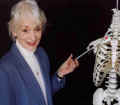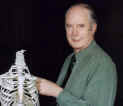 |
 |
 |
Helping You To Achieve ©™

![]()
Helping You To Achieve ©™
|
|
Mark with a surface marking pen the line of the second Metacarpo-phalangeal joint on the dorsal surface of the Hand on a model in the Anatomical position with a time limit of one minute.
Objective No 26 - Criteria to be demonstrated. 1. Request the model to make a clenched fist with the right hand. 2. Mark the contour formed by the Head of the second metacarpal bone. 3. Request the model to relax the hand so that the fingers may be passively moved. 4. Grasping the right index finger of the model with the palmar surface of the examiner's fingers of the Left hand in contact with the palmar surface of the right index finger of the model, apply gentle pain free traction. 5. Gently flex the finger joints of the model's index finger to a right angle with the palm. 6. Request the model to flex and extend the index finger while the examiner applies traction and resists the action of flexion and extension performed by the model. 7. The Thumb tip of the examiner may be placed on the joint immediately distal to the Head of the Second Metacarpal where a gliding movement can be observed taking place. 8. Mark on the dorsal surface of the hand where the movement is observed taking place. 9. The line represents the Dorsal surface marking of the Second Metacarpo-phalangeal Joint.
|
Service ProvisionBronze. Students may take up a ,'Free start up ' package consisting of 100 of the behavioural objectives and criteria based on common questions asked in Living Anatomy. These are available free of charge on this Website. Silver. Students may buy a copy of the book "Surface and Living Anatomy" (ISBN: 0 7234 3261 9) which comes with a CD Rom (Windows PC format) containing 230 objectives which includes the 100 behavioural objectives contained in the Bronze Service. Gold "Helping you to Achieve" Contact Information
|